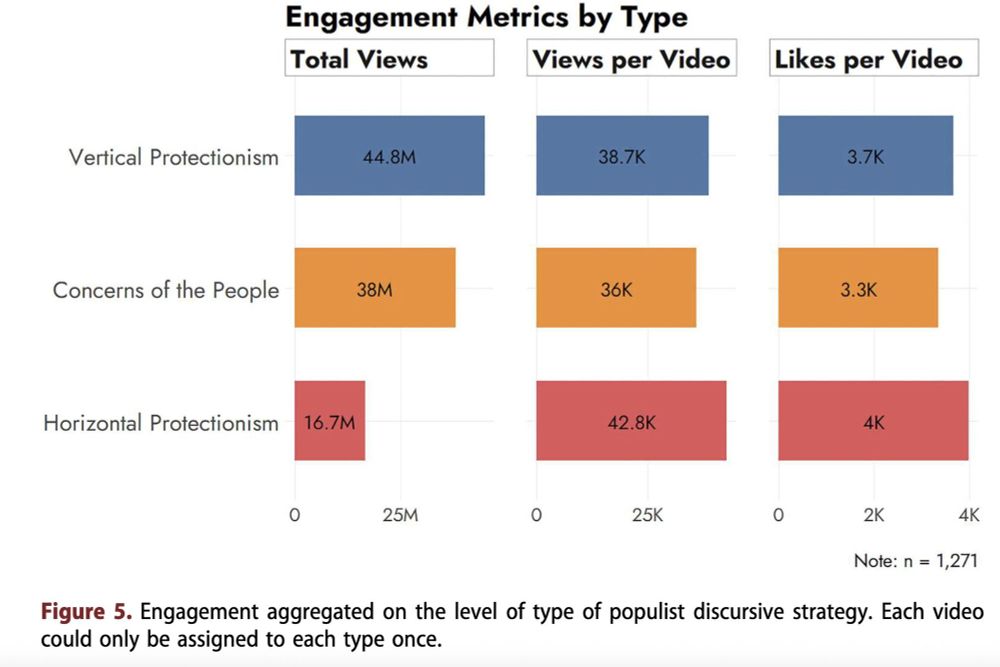
Political & Climate (Protest) Communication
Website: https://www.hendrik-meyer.com
Google Scholar: https://scholar.google.com/citations?user=j3fDB9oAAAAJ&hl=en
– AfD dominance: higher overall engagement rate and far greater output (from accounts with ≥100k lifetime likes) than all other German parties combined.

– AfD dominance: higher overall engagement rate and far greater output (from accounts with ≥100k lifetime likes) than all other German parties combined.
– Anti-elitism and out-group attacks generated higher per-video engagement.
– Yet most content leaned toward anti-elite messages or concern-focused themes (economy/inflation, security, rights/freedoms).

– Anti-elitism and out-group attacks generated higher per-video engagement.
– Yet most content leaned toward anti-elite messages or concern-focused themes (economy/inflation, security, rights/freedoms).
We identified 12 themes organized into 3 populist types:
1. Horizontal protectionism (identity/out-group: migrants, “wokeism”)
2. Vertical protectionism (anti-elitism/anti-institutionalism)
3. Concerns of the people (economy/inflation, security, freedoms)

We identified 12 themes organized into 3 populist types:
1. Horizontal protectionism (identity/out-group: migrants, “wokeism”)
2. Vertical protectionism (anti-elitism/anti-institutionalism)
3. Concerns of the people (economy/inflation, security, freedoms)
“Beyond anti-elitism and out-group attacks: How concerns shape the AfD’s #populist representation on German #TikTok during the 2024 #EU #elections”
/w @julialenz.bsky.social, L. Rodeck & @drfell.bsky.social
(⬇️ 🧵)

“Beyond anti-elitism and out-group attacks: How concerns shape the AfD’s #populist representation on German #TikTok during the 2024 #EU #elections”
/w @julialenz.bsky.social, L. Rodeck & @drfell.bsky.social
(⬇️ 🧵)
"From disruptive protests to disrupted news frames: Comparing German news on climate protests"
with @mikefarjam.bsky.social, Helena Rauxloh & Michael Brüggemann

"From disruptive protests to disrupted news frames: Comparing German news on climate protests"
with @mikefarjam.bsky.social, Helena Rauxloh & Michael Brüggemann
Antagonists were twice as toxic when addressing supporters than when talking to each other—especially so in debates about disruptive protests.

Antagonists were twice as toxic when addressing supporters than when talking to each other—especially so in debates about disruptive protests.
In the Fridays for Future debate, supportive communities were larger and more diverse.
In the Letzte Generation debate, the network was more evenly split between supporters and antagonists.

In the Fridays for Future debate, supportive communities were larger and more diverse.
In the Letzte Generation debate, the network was more evenly split between supporters and antagonists.
In both debates, antagonists attacked protesters while supporters called for climate action & defended protests.
Both debates were asymmetrically polarized—disruptive protest debates showed greater "Discursive Polarization":

In both debates, antagonists attacked protesters while supporters called for climate action & defended protests.
Both debates were asymmetrically polarized—disruptive protest debates showed greater "Discursive Polarization":
How do (non-)disruptive #climate #protests shape social media debates?
We analyzed ~5M Twitter/X posts on #FFF & #LetzteGeneration: Disruptive protests generate more engagement—but also more polarization, driven by right-wing/conservative users: doi.org/10.1177/2056...

How do (non-)disruptive #climate #protests shape social media debates?
We analyzed ~5M Twitter/X posts on #FFF & #LetzteGeneration: Disruptive protests generate more engagement—but also more polarization, driven by right-wing/conservative users: doi.org/10.1177/2056...





Accepted OSF preprint: osf.io/preprints/os...

Accepted OSF preprint: osf.io/preprints/os...


